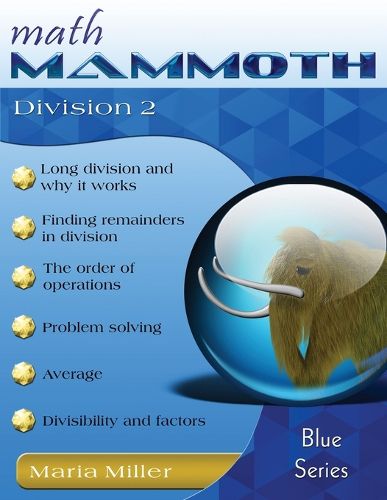Readings Newsletter
Become a Readings Member to make your shopping experience even easier.
Sign in or sign up for free!
You’re not far away from qualifying for FREE standard shipping within Australia
You’ve qualified for FREE standard shipping within Australia
The cart is loading…






This title is printed to order. This book may have been self-published. If so, we cannot guarantee the quality of the content. In the main most books will have gone through the editing process however some may not. We therefore suggest that you be aware of this before ordering this book. If in doubt check either the author or publisher’s details as we are unable to accept any returns unless they are faulty. Please contact us if you have any questions.
Math Mammoth Division 2 is a continuation from the Math Mammoth Division 1. It focuses on the topics of long division, remainder, problem solving, average, divisibility, and factors. The book is most suitable for fourth grade.
We start out by reviewing basic division facts by single-digit numbers (such as 24 / 4 or 56 / 7). After that, we study terminology of division and dividing numbers by whole tens and hundreds (such as 400 / 20). Next students practice the order of operations-this time with division as one of the operations.
Then we study the concept of remainder, preparing students for the upcoming lessons on long division. At first, the concept of remainder is presented visually. Soon, students solve simple division problems with a remainder, written with the long division symbol (or long division "corner", as I like to call it).
Next comes a set of lessons intended to teach long division in several small steps. We start with divisions where each of the digits in the dividend (thousands, hundreds, tens, and ones) can be divided evenly by the divisor (for example, 3096 / 3). As the next step, there is a remainder in the ones. Then, the divisions have a remainder in the tens. Finally, there is a remainder in the hundreds and in the thousands, and this completes the step-by-step learning process for long division. The lessons also include lots of word problems to solve.
After long division, we study the concept of average, which is a nice application of division, and problems that involve finding a fractional part of a quantity using division. For example, we can find 3/4 of a number by first finding 1/4 (dividing by 4) and then multiplying the result by 3. Students get help from visual bar models to solve the problems.
The last section deals with elementary number theory. We study basic divisibility rules (though not all of them), prime numbers, and finding all factors of a given two-digit number.
$9.00 standard shipping within Australia
FREE standard shipping within Australia for orders over $100.00
Express & International shipping calculated at checkout
This title is printed to order. This book may have been self-published. If so, we cannot guarantee the quality of the content. In the main most books will have gone through the editing process however some may not. We therefore suggest that you be aware of this before ordering this book. If in doubt check either the author or publisher’s details as we are unable to accept any returns unless they are faulty. Please contact us if you have any questions.
Math Mammoth Division 2 is a continuation from the Math Mammoth Division 1. It focuses on the topics of long division, remainder, problem solving, average, divisibility, and factors. The book is most suitable for fourth grade.
We start out by reviewing basic division facts by single-digit numbers (such as 24 / 4 or 56 / 7). After that, we study terminology of division and dividing numbers by whole tens and hundreds (such as 400 / 20). Next students practice the order of operations-this time with division as one of the operations.
Then we study the concept of remainder, preparing students for the upcoming lessons on long division. At first, the concept of remainder is presented visually. Soon, students solve simple division problems with a remainder, written with the long division symbol (or long division "corner", as I like to call it).
Next comes a set of lessons intended to teach long division in several small steps. We start with divisions where each of the digits in the dividend (thousands, hundreds, tens, and ones) can be divided evenly by the divisor (for example, 3096 / 3). As the next step, there is a remainder in the ones. Then, the divisions have a remainder in the tens. Finally, there is a remainder in the hundreds and in the thousands, and this completes the step-by-step learning process for long division. The lessons also include lots of word problems to solve.
After long division, we study the concept of average, which is a nice application of division, and problems that involve finding a fractional part of a quantity using division. For example, we can find 3/4 of a number by first finding 1/4 (dividing by 4) and then multiplying the result by 3. Students get help from visual bar models to solve the problems.
The last section deals with elementary number theory. We study basic divisibility rules (though not all of them), prime numbers, and finding all factors of a given two-digit number.